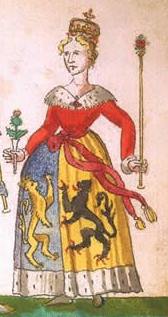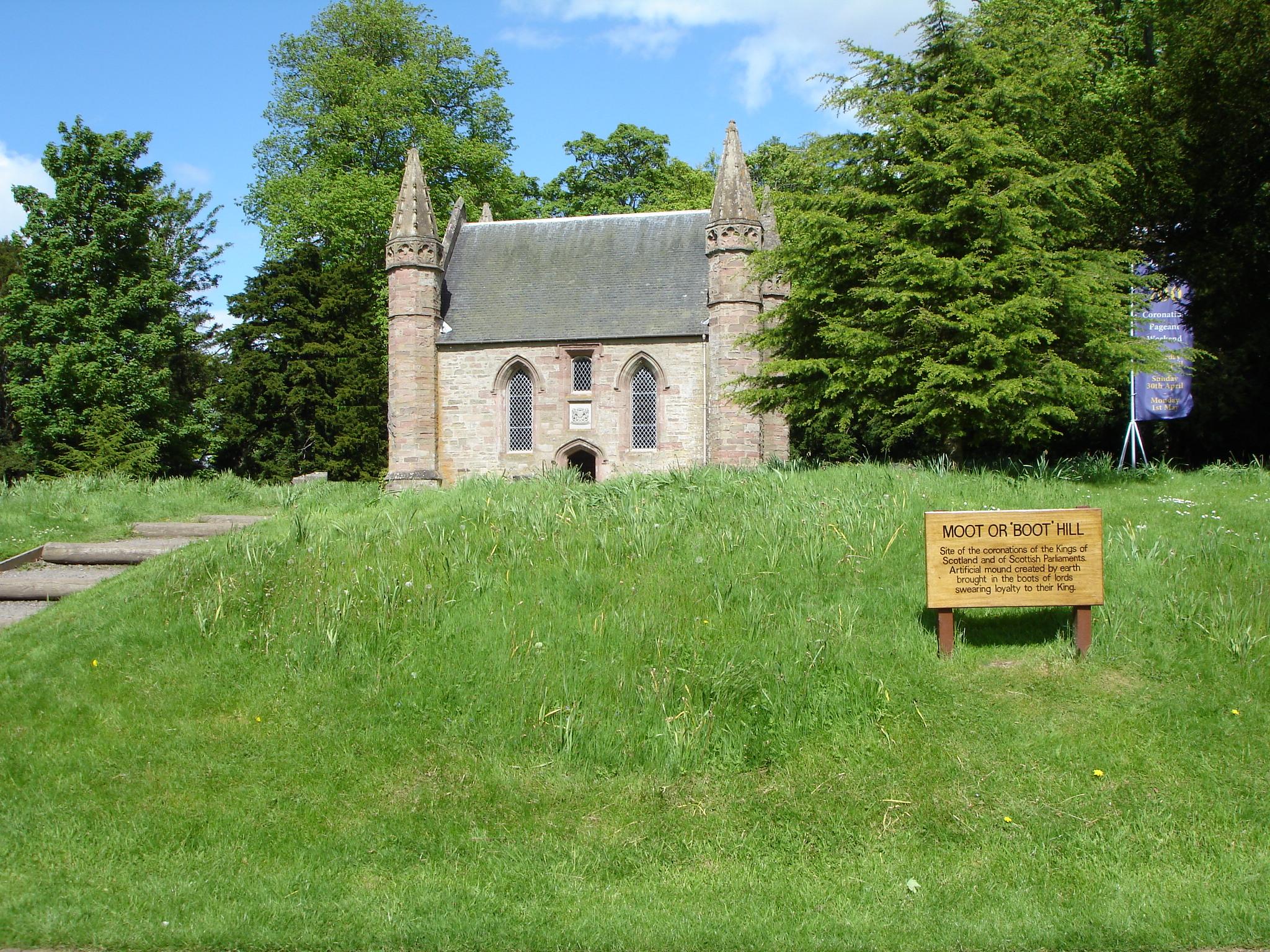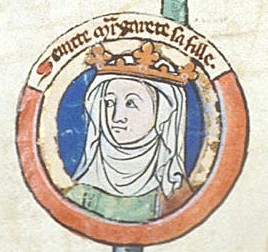|
Holyroodhouse Palace
The Palace of Holyroodhouse ( or ), commonly referred to as Holyrood Palace or Holyroodhouse, is the official residence of the British monarch in Scotland. Located at the bottom of the Royal Mile in Edinburgh, at the opposite end to Edinburgh Castle, Holyroodhouse has served as the principal royal residence in Scotland since the 16th century, and is a setting for state occasions and official entertaining. The late Queen Elizabeth II spent one week in residence at Holyroodhouse at the beginning of each summer, where she carried out a range of official engagements and ceremonies. The 16th-century historic apartments of Mary, Queen of Scots, and the State Apartments, used for official and state entertaining, are open to the public throughout the year, except when members of the royal family are in residence. The Queen's Gallery was built at the western entrance to the Palace of Holyroodhouse and opened in 2002 to exhibit works of art from the Royal Collection. The gardens ... [...More Info...] [...Related Items...] OR: [Wikipedia] [Google] [Baidu] |
James II Of Scotland
James II (16 October 1430 – 3 August 1460) was King of Scots from 1437 until his death in 1460. The eldest surviving son of James I of Scotland, he succeeded to the Scottish throne at the age of six, following the assassination of his father. The first Scottish monarch not to be crowned at Scone, James II's coronation took place at Holyrood Abbey in March 1437. After a reign characterised by struggles to maintain control of his kingdom, he was killed by an exploding cannon at Roxburgh Castle in 1460. Life James was born in Holyrood Abbey.Grants "Old and New Edinburgh" He was the son of King James I and Joan Beaufort. By his first birthday, his only brother, his older twin, Alexander, had died, thus leaving James as heir apparent with the title Duke of Rothesay. On 21 February 1437, James I was assassinated, and the six-year-old James immediately succeeded him as James II. He was crowned in Holyrood Abbey by Abbot Patrick on 23 March 1437. On 3 July 1449, the eighteen-ye ... [...More Info...] [...Related Items...] OR: [Wikipedia] [Google] [Baidu] |
David II Of Scotland
David II (5 March 1324 – 22 February 1371) was King of Scots from 1329 until his death in 1371. Upon the death of his father, Robert the Bruce, David succeeded to the throne at the age of five, and was crowned at Scone in November 1331, becoming the first Scottish monarch to be anointed at their coronation. During his childhood Scotland was governed by a series of guardians, and Edward III of England sought to take advantage of David's minority by supporting an invasion of Scotland by Edward Balliol, beginning the Second War of Scottish Independence. Following the English victory at the Battle of Halidon Hill in 1333, David, his queen and the rump of his government were evacuated to France, where he remained in exile until it was safe for him to return to Scotland in 1341. In 1346, David invaded England in support of France during the Hundred Years' War. His army was defeated at the Battle of Neville's Cross and he was captured and held as a prisoner in England for eleven year ... [...More Info...] [...Related Items...] OR: [Wikipedia] [Google] [Baidu] |
Robert The Bruce
Robert I (11 July 1274 – 7 June 1329), popularly known as Robert the Bruce (Scottish Gaelic: ''Raibeart an Bruis''), was King of Scots from 1306 to his death in 1329. One of the most renowned warriors of his generation, Robert eventually led Scotland during the First War of Scottish Independence against England. He fought successfully during his reign to regain Scotland's place as an independent kingdom and is now revered in Scotland as a national hero. Robert was a fourth great-grandson of King David I, and his grandfather, Robert de Brus, 5th Lord of Annandale, was one of the claimants to the Scottish throne during the "Great Cause". As Earl of Carrick, Robert the Bruce supported his family's claim to the Scottish throne and took part in William Wallace's revolt against Edward I of England. Appointed in 1298 as a Guardian of Scotland alongside his chief rival for the throne, John Comyn of Badenoch, and William Lamberton, Bishop of St Andrews, Robert resigned in 13 ... [...More Info...] [...Related Items...] OR: [Wikipedia] [Google] [Baidu] |
Treaty Of Edinburgh–Northampton
The Treaty of Edinburgh–Northampton was a peace treaty signed in 1328 between the Kingdoms of England and Scotland. It brought an end to the First War of Scottish Independence, which had begun with the English party of Scotland in 1296. The treaty was signed in Edinburgh by Robert the Bruce, King of Scots, on 17 March 1328, and was ratified by the Parliament of England meeting in Northampton on 1 May. The terms of the treaty stipulated that in exchange for £20,000 sterling, the English Crown would recognise: * The Kingdom of Scotland as fully independent; * Robert the Bruce, and his heirs and successors, as the rightful rulers of Scotland; * The border between Scotland and England as that recognised under the reign of Alexander III (1249–1286). One of two copies of the document, which was written in French, is held by the National Archives of Scotland in Edinburgh. However, the document does not constitute the entire peace treaty, which was contained in a number of i ... [...More Info...] [...Related Items...] OR: [Wikipedia] [Google] [Baidu] |
Parliament Of Scotland
The Parliament of Scotland ( sco, Pairlament o Scotland; gd, Pàrlamaid na h-Alba) was the legislature of the Kingdom of Scotland from the 13th century until 1707. The parliament evolved during the early 13th century from the king's council of bishops and earls, with the first identifiable parliament being held in 1235 during the reign of Alexander II, when it already possessed a political and judicial role. A unicameral institution, for most of its existence the Parliament consisted of the three estates of clergy, nobility, and the burghs. By the 1690s it comprised the nobility, the shires, the burghs, and various officers of state. Parliament gave consent for the raising of taxation and played an important role in the administration of justice, foreign policy, war, and the passing of a broad range of legislation. Parliamentary business was also carried out by "sister" institutions, such as General Councils or Conventions of Estates, which could both carry out much bu ... [...More Info...] [...Related Items...] OR: [Wikipedia] [Google] [Baidu] |
William The Lion
William the Lion, sometimes styled William I and also known by the nickname Garbh, "the Rough"''Uilleam Garbh''; e.g. Annals of Ulster, s.a. 1214.6; Annals of Loch Cé, s.a. 1213.10. ( 1142 – 4 December 1214), reigned as King of Scots from 1165 to 1214. His 48-year-long reign was the second longest in Scottish history, and the longest for a Scottish monarch before the Union of the Crowns in 1603. Early life William was born around 1142, during the reign of his grandfather King David I of Scotland. His parents were the king's son Henry and Ada de Warenne. William was around 10 years old when his father died in 1152, making his elder brother Malcolm the heir apparent to their grandfather. From his father, William inherited the Earldom of Northumbria. David I died the next year, and William became heir presumptive to the new king, Malcolm IV. In 1157, William lost the Earldom of Northumbria to Henry II of England. Reign Malcolm IV did not live for long, and upon his death on 9 D ... [...More Info...] [...Related Items...] OR: [Wikipedia] [Google] [Baidu] |
Saint Margaret Of Scotland
Saint Margaret of Scotland ( gd, Naomh Maighréad; sco, Saunt Marget, ), also known as Margaret of Wessex, was an English princess and a Scottish queen. Margaret was sometimes called "The Pearl of Scotland". Born in the Kingdom of Hungary to the expatriate English prince Edward the Exile, Margaret and her family returned to England in 1057. Following the death of king Harold II at the Battle of Hastings in 1066, her brother Edgar Ætheling was elected as King of England but never crowned. After she and her family fled north, Margaret married Malcolm III of Scotland by the end of 1070. Margaret was a very pious Christian, and among many charitable works she established a ferry across the Firth of Forth in Scotland for pilgrims travelling to St Andrews in Fife, which gave the towns of South Queensferry and North Queensferry their names. Margaret was the mother of three kings of Scotland, or four, if Edmund of Scotland (who ruled with his uncle, Donald III) is counted, and of a qu ... [...More Info...] [...Related Items...] OR: [Wikipedia] [Google] [Baidu] |
True Cross
The True Cross is the cross upon which Jesus was said to have been crucified, particularly as an object of religious veneration. There are no early accounts that the apostles or early Christians preserved the physical cross themselves, although protective use of the sign of the cross was common by at least the 2nd century. Post-Nicene historians such as Socrates of Constantinople relate that Helena, the mother of the Roman emperor ConstantineI, travelled to the Holy Land in the years 326–328, founding churches and establishing relief agencies for the poor. The late 4th-century historians Gelasius of Caesarea and Tyrannius Rufinus claimed that while there she discovered the hiding place of three crosses that were believed to have been used at the crucifixion of Jesus and the two thieves, St. Dismas and Gestas, executed with him. To one cross was affixed the titulus bearing Jesus's name, but according to Rufinus, Helena was not sure until a miracle revealed that this was t ... [...More Info...] [...Related Items...] OR: [Wikipedia] [Google] [Baidu] |
David I Of Scotland
David I or Dauíd mac Maíl Choluim (Modern: ''Daibhidh I mac haoilChaluim''; – 24 May 1153) was a 12th-century ruler who was Prince of the Cumbrians from 1113 to 1124 and later King of Scotland from 1124 to 1153. The youngest son of Malcolm III and Margaret of Wessex, David spent most of his childhood in Scotland, but was exiled to England temporarily in 1093. Perhaps after 1100, he became a dependent at the court of King Henry I. There he was influenced by the Anglo-French culture of the court. When David's brother Alexander I died in 1124, David chose, with the backing of Henry I, to take the Kingdom of Scotland (Alba) for himself. He was forced to engage in warfare against his rival and nephew, Máel Coluim mac Alaxandair. Subduing the latter seems to have taken David ten years, a struggle that involved the destruction of Óengus, Mormaer of Moray. David's victory allowed expansion of control over more distant regions theoretically part of his Kingdom. After the death of ... [...More Info...] [...Related Items...] OR: [Wikipedia] [Google] [Baidu] |
1128
Year 1128 ( MCXXVIII) was a leap year starting on Sunday (link will display the full calendar) of the Julian calendar. Events By place Byzantine Empire * Byzantine–Hungarian War: Emperor John II (Komnenos) defeats the Hungarians and their Serbian allies at the fortress of Haram (or Chramon), which is modern-day Nova Palanka. Europe * June 24 – Battle of São Mamede: Count Alfonso I (Henriques) defeats the forces led by his mother, Queen Theresa of Portugal, near Guimarães, and gains control of the county. Alfonso styles himself "Prince of Portugal". * June 29 – Conrad III, anti-king of Germany, is crowned "King of Italy" by Archbishop Anselmo della Pusterla at Monza in Lombardy. * July 27 – The city of Bruges (modern Belgium) is founded. It receives its city charter – as well new walls and canals are built. * Pope Honorius II invests Roger II of Sicily as duke of Apulia at Benevento, after his failure to form an coalition against Roger. ... [...More Info...] [...Related Items...] OR: [Wikipedia] [Google] [Baidu] |








